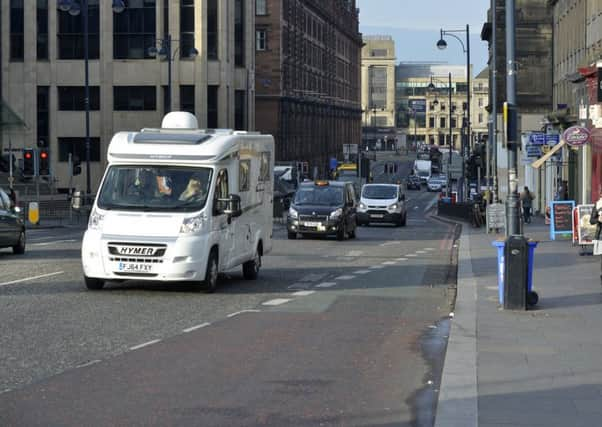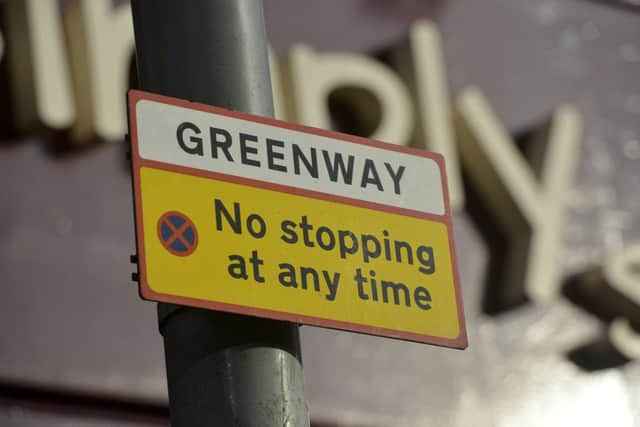Bus lane restrictions to be relaxed in Capital


But there were warnings today that car drivers worried about being caught out would still avoid the lanes unless there was a major public awareness campaign to tell them: “Don’t fear the Greenways”.
The council agreed in June last year to standardise the operating times for bus lanes by converting all-day lanes to peak-only as a trial.
The 18-month experiment is due to end in March next year.


Advertisement
Hide AdAdvertisement
Hide AdNow a report has concluded that “no significant issues” were thrown up during the trial.
And today, the council’s transport and environment committee is set to agree to make the changes permanent.
Neil Greig, head of policy for the Institute of Advanced Motorists in Scotland, said the move was “a victory for common sense”.
He said: “There was no point in half the road lying empty when there was no demand from the buses. So I’m glad they’re making it permanent.”


Advertisement
Hide AdAdvertisement
Hide AdBut he said a massive effort – including an awareness campaign and increased signage – would be needed if the city is to make the most of freeing up extra road space for other drivers.
Motorists would need to be reassured that they were not going to be snapped by CCTV cameras for using the bus lanes during the day.
He said: “The problem was the early experience of bus lane cameras was entirely negative.
“People were scared by the stories of people being caught turning into side streets and the operating times not working properly.
Advertisement
Hide AdAdvertisement
Hide Ad“There is a lack of trust that a camera won’t catch you even though you have the right to be there.”
He said there would always be a risk of confusion. But he said the council would have to work hard to make sure the changed rules were communicated to the public.
“I would support what they are doing, but we need an awareness campaign and better signs to let people know they can go in these lanes outside peak times.
“It’s not job done on the bus lanes. We need to make signs clearer and more legible and make sure they are not going to be obscured by parked vehicles.”
Advertisement
Hide AdAdvertisement
Hide AdHistorically there have been three kinds of bus lanes in Edinburgh – all-day lanes enforced 6.30am-7.30pm; peak-time lanes which operate at rush hours, 7.30-9.30am and 4-6.30pm; and a handful of bus lanes which are right around the clock, mainly located at bus gates, park and rides and in places where a single bus lane runs against the flow of traffic.
The pilot effectively scrapped all-day lanes and also allowed motorcycles to use bus lanes at any time, along with cycles and taxis.
Councillor Nick Cook, the Tory group’s transport spokesman, backed the move to make the peak-only restrictions permanent.
But he echoed concerns about motorists’ reluctance to use the bus lanes.
Advertisement
Hide AdAdvertisement
Hide AdHe said: “The council has a responsibility to keep the city moving in the face of ever-increasing traffic flows and I very much welcome this move in principle.
“Given the long-standing concerns over the operation of things like bus lane cameras it’s important that signage is changed accordingly and that it is clear to drivers when they can and cannot use the lanes without fear of penalty.”
Cllr Cook claimed the council’s record on transport issues over the past five years had been “very much against the motorist” and said drivers would welcome the opening up of the bus lanes.
“Given the council’s track record on the trams and the 20mph limit, which have increased congestion, I think residents across the city will welcome an initiative that will help to increase traffic flows.
Advertisement
Hide AdAdvertisement
Hide Ad“But the council needs to be absolutely clear about the benefits it will bring and the times when it applies.”
Concerns were voiced before the trial started that lifting the off-peak ban on cars using the bus lanes would lead to slower journey times.
In response to the experiment, Lothian Buses said it had compared journey times on a range of bus lane corridors during a six-week period in 2014 and the same period in 2015. “The analysis did not show a conclusive effect on transit times but did show a consistent marginal increase.”
A report on the pilot by council officials said analysis of the speed and volume of traffic before and after the trial was “inconclusive” with volumes and speeds increasing at some sites whilst reducing at others.
Advertisement
Hide AdAdvertisement
Hide AdDelays in obtaining data on road collisions before and after the pilot meant there was “not a sufficient after-period for a meaningful comparison”.
And it said to assess changes in air quality, data trends had to be monitored over a minimum period of six years.
But the report said: “Comparison of the before and after data has not identified any significant issues with the experiment to standardise bus lane times.
“Retaining the peak hour operational hours introduces a single operational category for approximately 90 per cent of the city’s bus lane network. This should reduce driver’s confusion with operating hours and reduce the need for any enhanced bus lane signage.”
Advertisement
Hide AdAdvertisement
Hide AdThe report also endorsed allowing motorcycles into bus lanes.
A survey of 795 people conducted to assess the pilot, focusing on pedestrians over 65, pedestrians with children under 12 and people cycling, found a significant number felt traffic conditions had worsened in the past year, but a majority said there was no change.
And 53 per cent said they preferred weekday peak-time bus lanes, although 63 per cent said bus lanes should also operate at the weekend.
Cycling campaign group Spokes said public perception was journeys took longer and streets were less safe for cycling. “If the aim is also to reduce driver confusion, then seven-day operation is by far the clearest of all options,” said the group.
Advertisement
Hide AdAdvertisement
Hide AdAnd Living Streets said 35 per cent of pedestrians experienced difficulties crossing the road with 24 per cent feeling less safe.
The Greens are opposing the permanent peak-only arrangement. Transport spokesperson Nigel Bagshaw said: “This is a really bizarre decision. There has been no public clamour for the changes, they would appear to have little benefit to drivers’ journey times, and they are entirely contrary to the council’s own policy of prioritising active and public transport.
“If the city is serious about increasing walking, cycling and public transport use, it shouldn’t be bringing in measures which have precisely the opposite effect.
“Living Streets, Spokes and Lothian Buses all have issues with the changes and we should listen to them.
Advertisement
Hide AdAdvertisement
Hide Ad“We want to see improvements in bus lanes and that’s what we keep pushing for.”
Despite the move to peak-only operation, the council report said Calder Road would be considered for a 24-hour bus lane. It said the road was a cycle link to destinations including Napier and Heriot Watt Universities. “However, it is a dual carriageway with a 40mph speed limit. A 24-hour bus lane could encourage greater cycle use in this area and will be given consideration.”
Transport convener Lesley Hinds said the bus lane pilot had been successful and the change would end confusion.
“It was frustrating for drivers that, depending on where you were in the city, some bus lanes were all day, some were Saturdays as well, some were peak times only and some were not.
Advertisement
Hide AdAdvertisement
Hide Ad“Now everyone will be aware that at peak times, Monday to Friday, you don’t go into bus lanes.
“The cyclists and the bus companies said there might be a difficulties in terms of bus journey times, but Lothian Buses are saying it has not made a vast difference.
“Moving to peak-only operation will make it consistent and people can be very clear, bus lanes operate at peak times.”
Cameras put motorists off
BUS lane cameras to crack down on drivers using the Greenways caught more than 3600 offenders within the first three weeks of being switched on.
Advertisement
Hide AdAdvertisement
Hide AdFines were waived during that initial period, with motorists handed warning notices instead. But otherwise the council would have netted up to £220,000 from those early breaches.
And there was soon controversy over the cameras, which use Automatic Number Plate Recognition to record vehicles that enter the Greenways.
Motoring groups said drivers would have to be careful not to stray into the Greenways accidentally when preparing to turn at a junction because cameras were positioned in such a way they would record the vehicle.
Some 82 drivers were caught using the Greenways more than five times each in the first 14 days of the scheme, including one private hire driver who was hit with £1800 worth of fines after being snapped by bus lane cameras 30 times over the two weeks.
Advertisement
Hide AdAdvertisement
Hide AdAnd at the busiest ticket hotspot, in Calder Road, motorists were being hit with a fine once every two minutes during the first six days of the initiative.
And the fairness and reliability of the cameras were called into question when one woman received a £60 fine for driving in a bus lane on Willowbrae Road at 7.29am and 57 seconds – three seconds before the cameras are supposed to turn on.
Families in Willowbrae Avenue complained of being landed with £60 fines every day because they had to drive through a bus lane to get into their street.
And a minibus driver who was transporting severely disabled children to school was hit with 27 fines for driving through bus lanes despite checking with police being told he could use the lanes.
In 2014 more than 25,000 motorists were fined for using bus lanes.